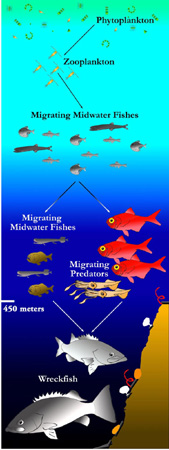When the Sun makes itself scarce and temperatures begin to plummet, bears and many other animals settle in for a long winter’s nap. They slow their metabolism and live off the fat they stored up during the summer, hibernating for up to several months.
 Phytoplankton support much of the ocean food web. Credit: National Oceanic and Atmospheric Administration
Phytoplankton support much of the ocean food web. Credit: National Oceanic and Atmospheric AdministrationSome of the tiniest creatures in the sea can hibernate, too. But like Rip Van Winkle, their naps can last for decades. And their awakening can be important not just for their own species, but for life on the entire planet.
These creatures are species of microscopic plant-like organisms known as phytoplankton. They support much of the ocean food chain — they’re eaten by tiny animals, which in turn are eaten by larger creatures, and so on.
But when times are tough — when there’s not enough food or sunlight, or when temperatures are too extreme — they can enter a sort of hibernation. During this “resting stage,” they settle to the ocean floor. They can form a thicker shell to protect their bodies, which basically shut down. When conditions improve, they wake up and resume life as normal. These resurrections sometimes produce red tides, as huge numbers of these organisms suddenly appear.
Scientists have dug up phytoplankton that have been hibernating in ocean sediments for decades — and in some cases, almost a century.
And a recent study suggests that these resting stages may help life on Earth recover from catastrophic events. An example is the asteroid impact that may have killed the dinosaurs. We’ll have more about that on our next program.

